
How to Rotate Tires for Even Wear: A Step-by-Step Guide to Prolonging Tire Life and Enhancing Vehicle Performance
When you think of Friends, you immediately picture the iconic moments of Ross, Rachel, Monica, Chandler, Joey, and Phoebe—each character contributing to the laughter and drama that made the show unforgettable. But what if we told you that one tiny character, who didn’t even speak for most of her appearances, reshaped the entire series? Yes, we’re talking about Ross and Rachel’s daughter, Emma.
Emma’s arrival brought a fresh dynamic to the group, altering relationships, sparking new storylines, and even changing the show’s direction. But just like how rotating tires for even wear keeps your car running smoothly 
Table of Contents
ToggleHow Often Should You Rotate Your Tires?
Tire rotation is crucial to ensure even wear and extend the lifespan of your tires. But how often should you rotate them? Let’s break it down.
Industry Standard: Every 6,000 to 8,000 Miles
As a general rule of thumb, it’s recommended to rotate your tires every 6,000 to 8,000 miles (approximately every 6 months), or as specified by your vehicle manufacturer. This helps maintain balanced tire wear, ensuring that no one tire bears the brunt of the load more than others.
Factors That Influence Rotation Frequency
While the 6,000-8,000-mile guideline is a great starting point, there are several factors that may affect how often you should rotate your tires:
- Driving Conditions: If you frequently drive in stop-and-go traffic or on rough, uneven surfaces, your tires might wear out faster. In these cases, rotating more often (every 5,000 miles) can help.
- Vehicle Type: Different vehicles have different needs:
- Front-Wheel Drive: Tires often wear faster on the front. More frequent rotations may be needed to maintain even wear.
- Rear-Wheel Drive: Rear tires bear more weight during acceleration, so these might need rotation sooner.
- All-Wheel Drive (AWD): AWD vehicles often require more frequent rotations due to the constant use of all four tires. Be sure to follow manufacturer guidelines closely.
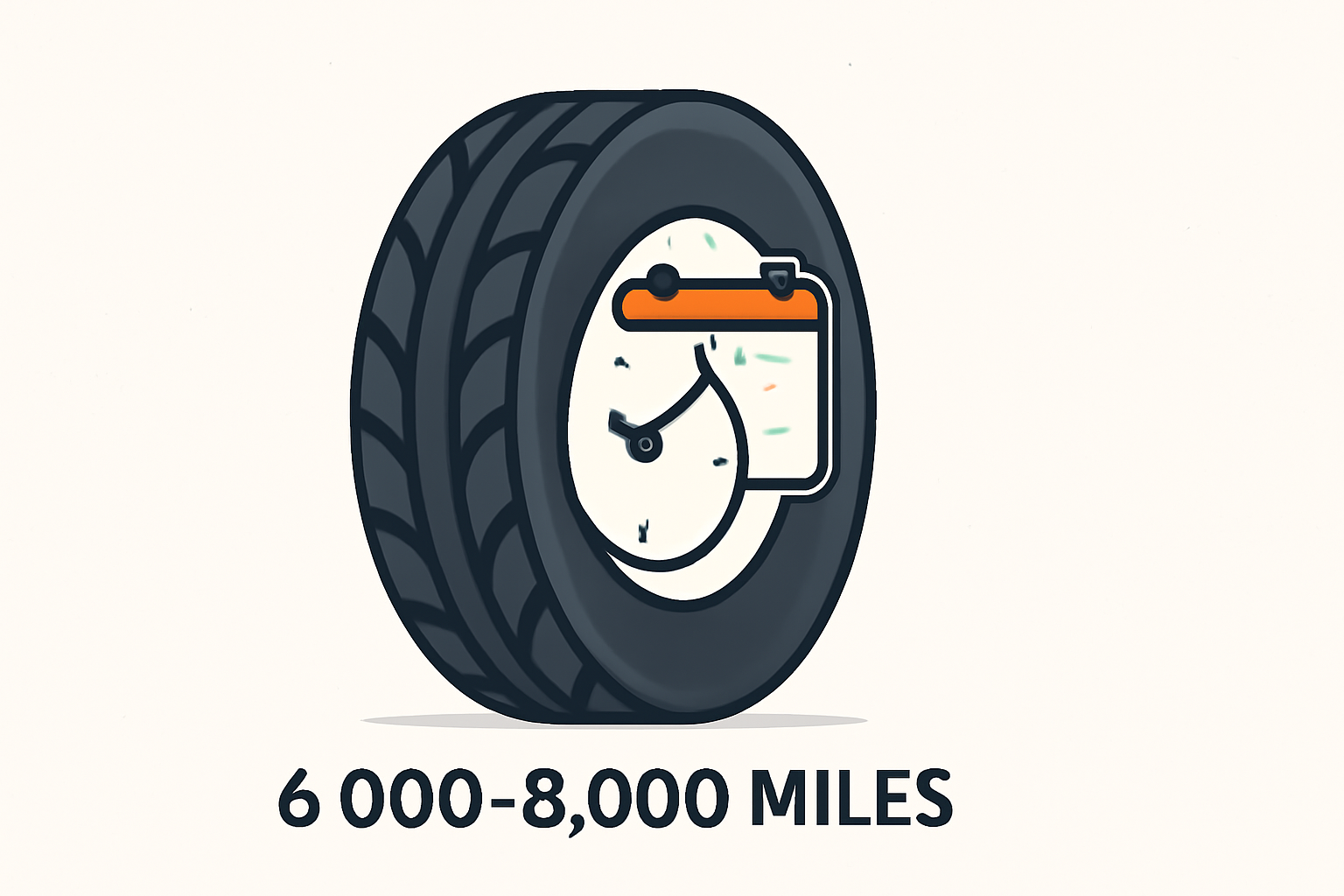
Signs It’s Time to Rotate Your Tires
While sticking to a rotation schedule is ideal, you should also keep an eye on your tires for signs that it’s time for a rotation. Here are some key indicators:
- Uneven Tire Tread: If you notice more wear on the inside or outside edges of your tires, it’s time for a rotation.
- Vibrations or Poor Handling: If your vehicle starts vibrating or pulling to one side while driving, your tires may be unevenly worn and need rotating.
Regular tire rotation not only prolongs the life of your tires but also helps your vehicle perform optimally, giving you a smoother ride and better gas mileage. So, make it a habit to check your tire wear and rotate them as needed—your tires (and wallet) will thank you!
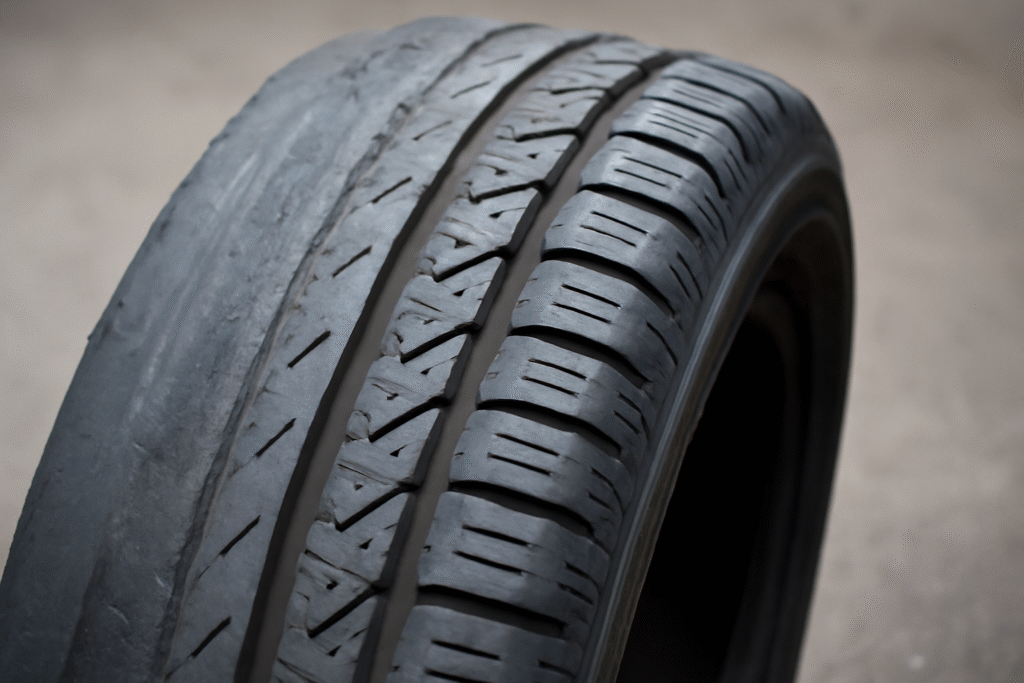
The Benefits of Regular Tire Rotation
Regular tire rotation is not just a maintenance task—it’s an investment in the longevity of your tires and the performance of your vehicle. Here’s why rotating your tires frequently is so important:
1. Prolongs Tire Life
One of the most significant benefits of tire rotation is that it extends the lifespan of your tires. By moving them around regularly, you ensure that no tire wears more quickly than the others. Front tires, for example, tend to wear faster on front-wheel drive cars. Rotating them with rear tires helps distribute the wear evenly, so you get the most out of your tire investment.
2. Improves Vehicle Handling and Safety
When tires wear unevenly, they can affect your vehicle’s handling, making it pull to one side or cause vibrations. Regular tire rotations ensure even tread wear, which improves steering control and overall handling. This is especially important for safety—having well-maintained tires ensures better traction and stability on the road.
3. Enhances Fuel Efficiency
Unevenly worn tires can cause your car to drag, increasing resistance as you drive. This can lead to higher fuel consumption. By rotating your tires and maintaining even tread, you reduce rolling resistance, making your vehicle more fuel-efficient. This can save you money at the pump over time!
4. Saves Money in the Long Run
Tire rotation helps you avoid premature tire replacement. By keeping your tires in good condition for longer, you delay the need to buy new ones, saving you money on costly replacements. Plus, it helps prevent other vehicle issues, such as suspension or alignment problems, which can be expensive to fix.
5. Reduces the Risk of Tire Failure
Tires that wear unevenly are more prone to issues like blowouts or flats. Regular rotations help identify early signs of tire damage or wear, so you can replace tires before they become a safety hazard. This proactive approach significantly reduces the risk of unexpected breakdowns.

Step-by-Step Guide: How to Rotate Tires for Even Wear
Rotating your tires at home can be an easy and satisfying task with the right tools and steps. Here’s your ultimate guide to ensuring even tire wear and improving your vehicle’s performance—without the hassle of a shop visit!
Step 1: Gather the Necessary Tools
Before you begin, make sure you have the right tools for the job:
- Car jack and jack stands
- Lug wrench
- Torque wrench
- Tire pressure gauge
- Gloves for safety
Step 2: Lift the Vehicle Safely
- Park your car on a flat, solid surface and engage the parking brake.
- Loosen the lug nuts on all four tires just slightly (don’t remove them fully yet). This prevents the tires from spinning when you lift the car.
- Use the car jack to lift one side of the vehicle at a time. Always place the jack under the frame or specified lifting points—check your vehicle manual for precise locations.
- Once the car is lifted, secure it with jack stands for added safety. Never rely on the jack alone.
Step 3: Remove the Tires
- Now that the car is securely elevated, remove the lug nuts completely and carefully take off the tires. Set them aside, and be mindful of how they are positioned for rotation.
Step 4: Rotate the Tires
There are different rotation patterns based on your vehicle type. Here’s how to rotate for the most common setups:
- Front-Wheel Drive (FWD):
- Front tires to the rear and move rear tires to the front, but swap sides.
- Example: Left front tire goes to the right rear, and right front tire goes to the left rear.
- Rear-Wheel Drive (RWD):
- Follow the same pattern as FWD, swapping front and rear tires and switching sides.
- All-Wheel Drive (AWD):
- Use the X-pattern: Swap front and rear tires and also switch sides. This helps distribute wear more evenly across all four tires.
- Directional Tires:
- If your tires are directional (designed to rotate only one way), do not cross sides. Simply move them from front to back and vice versa, keeping the same direction of rotation.
Step 5: Reinstall the Tires
- Place each tire back onto its wheel hub.
- Hand-tighten the lug nuts onto each tire but don’t tighten them fully yet. This prevents the tire from shifting while you’re lowering the vehicle.
Step 6: Lower the Vehicle and Tighten the Lug Nuts
- Carefully lower the vehicle back to the ground using the car jack.
- Once the car is securely on the ground, use your torque wrench to tighten the lug nuts in a star pattern. This ensures even pressure on the tires. Tighten to the manufacturer’s specified torque setting (found in your vehicle manual).
Step 7: Check Tire Pressure
After rotating the tires, always check the tire pressure to ensure they are properly inflated. Underinflated tires can cause uneven wear, while overinflated tires can lead to poor handling.
Step 8: Test Drive
Before calling it a day, take your vehicle for a short test drive to check for any unusual vibrations or handling issues. If everything feels smooth, you’ve done it right!
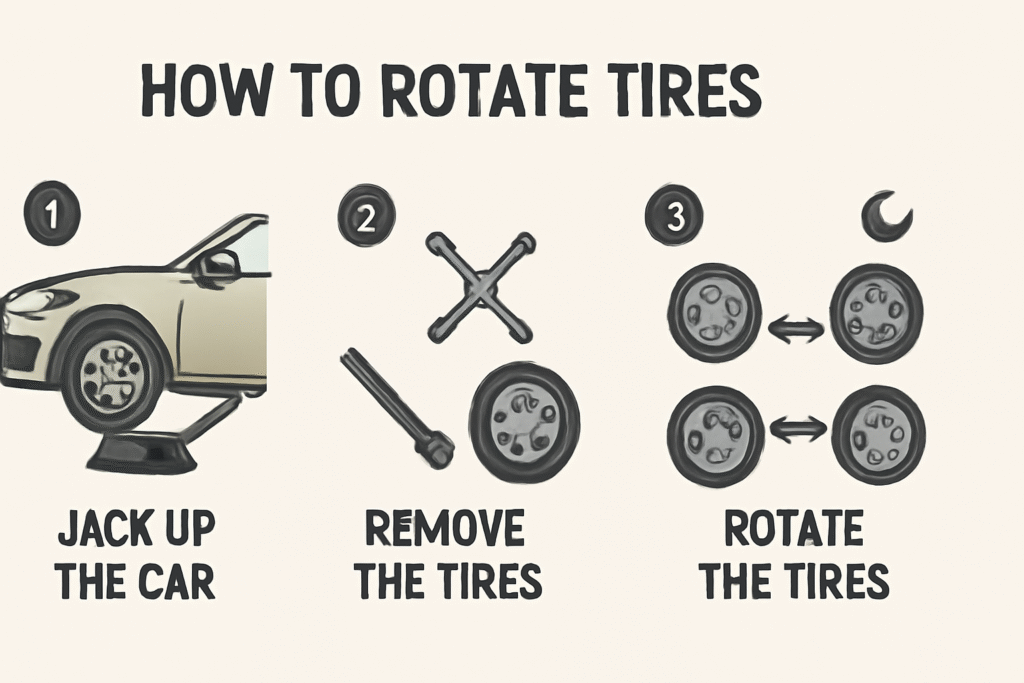
Best Practices and Tips for Tire Rotation
To get the most out of your tire rotation and ensure the best performance from your vehicle, here are some expert tips and best practices. Following these guidelines will make your rotations more effective, safer, and easier to manage!
1. Check Tire Pressure Before Rotation
Before you begin rotating your tires, always check the tire pressure. Properly inflated tires will wear evenly and perform better. Under-inflated or over-inflated tires can lead to irregular wear, even after rotation. Use a tire pressure gauge to make sure each tire is at the recommended pressure level (usually listed on a sticker inside the driver’s door).
2. Follow the Manufacturer’s Guidelines
Each vehicle is different, so it’s important to follow the manufacturer’s recommended rotation schedule and pattern. This can usually be found in your vehicle’s manual or on a label inside the driver’s door frame. Adhering to these recommendations will ensure you’re rotating your tires in the most effective way for your specific make and model.
3. Rotate All Four Tires
It’s easy to overlook the rear tires, but if your vehicle is equipped with all four tires, rotate them all. Even if your front tires are more worn, rotating all tires ensures that they wear evenly and that your vehicle performs optimally. This also helps you avoid issues with alignment and balancing down the line.
4. Inspect Tires for Damage
While rotating your tires, take the opportunity to inspect them for any visible damage. Look for signs of cuts, punctures, bulges, or objects stuck in the tread. If you notice anything unusual, it may be time to replace that tire before further damage occurs. It’s also a good time to check for even wear—if one tire is more worn than others, it could be a sign of misalignment or suspension issues.
5. Don’t Over-Tighten Lug Nuts
When you’re tightening the lug nuts after rotation, make sure you’re using the proper torque. Over-tightening the lug nuts can damage the tire or wheel, and it may make them harder to remove next time. A torque wrench ensures that the lug nuts are tightened to the vehicle manufacturer’s specifications, preventing these issues.
6. Rotate Tires Regularly, Even If You Don’t Drive Much
Even if your driving habits are limited, tire rotation should still be part of your regular maintenance routine. Tires can develop flat spots or uneven wear due to sitting in the same position for too long, especially if you leave your car parked for extended periods. Regular rotation helps to avoid these issues and keeps your tires in top shape.
7. Avoid Rotating Tires in Harsh Weather Conditions
Rotating tires in extreme weather conditions (like in the middle of a heavy snowstorm or rain) can be risky. It’s best to wait for dry, safe weather to ensure you have good visibility and a stable surface to work on. If you need to rotate your tires during poor weather, make sure the car is parked on level ground and use a high-quality car jack and jack stands for safety.
8. Professional Help When Needed
If you’re unsure about the rotation pattern for your vehicle or if you don’t have the necessary tools, it’s always best to leave the job to the professionals. Tire shops and service centers have the right equipment to rotate tires properly, and they can also check for other issues such as alignment or suspension problems that might be affecting tire wear.
Common Tire Rotation Mistakes to Avoid
While tire rotation is a simple process, there are a few common mistakes that can compromise its effectiveness and even damage your tires. Here’s a guide to the most frequent errors and how to avoid them, ensuring your tires stay in top condition for longer!
1. Ignoring Manufacturer’s Recommendations
One of the biggest mistakes you can make is not following the manufacturer’s recommended tire rotation schedule and pattern. Every vehicle is different, and ignoring the guidelines can lead to uneven wear, reduced tire life, and potential handling issues. Always check your vehicle manual for specific rotation advice.
2. Not Rotating All Four Tires
It might seem tempting to only rotate the tires that show signs of wear, but skipping a tire can cause imbalanced wear across your vehicle. Rotate all four tires, even if one or two appear to be in better condition. This ensures that all tires wear evenly, improving performance and safety.
3. Over-Tightening or Under-Tightening Lug Nuts
Over-tightening lug nuts is just as problematic as under-tightening them. Over-tightening can lead to tire or wheel damage, while under-tightening can cause the lug nuts to loosen over time, increasing the risk of a loose tire. Always use a torque wrench and follow the manufacturer’s torque specifications for a secure, even fit.
4. Rotating Tires in the Wrong Pattern
Using the wrong rotation pattern is a common mistake, especially if you’re unfamiliar with your vehicle’s drivetrain type. For example:
- FWD (Front-Wheel Drive): Front tires to the back and rear tires to the front, switching sides.
- RWD (Rear-Wheel Drive): Same as above, but rear tires to the front.
- AWD (All-Wheel Drive): An X-pattern is best.
Make sure you’re following the right rotation pattern for your vehicle to avoid uneven wear and performance issues.
5. Forgetting to Check Tire Pressure
Many people rotate their tires without checking tire pressure, but this can lead to problems down the road. Under-inflated or over-inflated tires can wear unevenly, even if you rotate them regularly. Always use a tire pressure gauge before and after rotation to ensure each tire is inflated to the proper pressure.
6. Rotating Tires in Poor Weather
Performing a tire rotation in extreme weather conditions—like heavy rain, snow, or ice—can make the process unsafe. Wet or slippery surfaces can cause instability when lifting the vehicle or handling the tires. Always rotate your tires on a dry, flat surface, and avoid doing so during bad weather.
7. Failing to Inspect Tires for Damage
Don’t just rotate your tires and call it a day! Always inspect your tires for visible damage (cuts, bulges, punctures) during each rotation. Catching damage early can save you from costly repairs and prevent safety hazards.
8. Not Rebalancing Tires After Rotation
If your tires have been reinstalled in a new position, it’s a good idea to rebalance them. Unbalanced tires can lead to uneven wear, vibrations while driving, and potentially costly suspension damage over time. If you notice vibrations or an uncomfortable ride after rotation, consider getting your tires balanced.
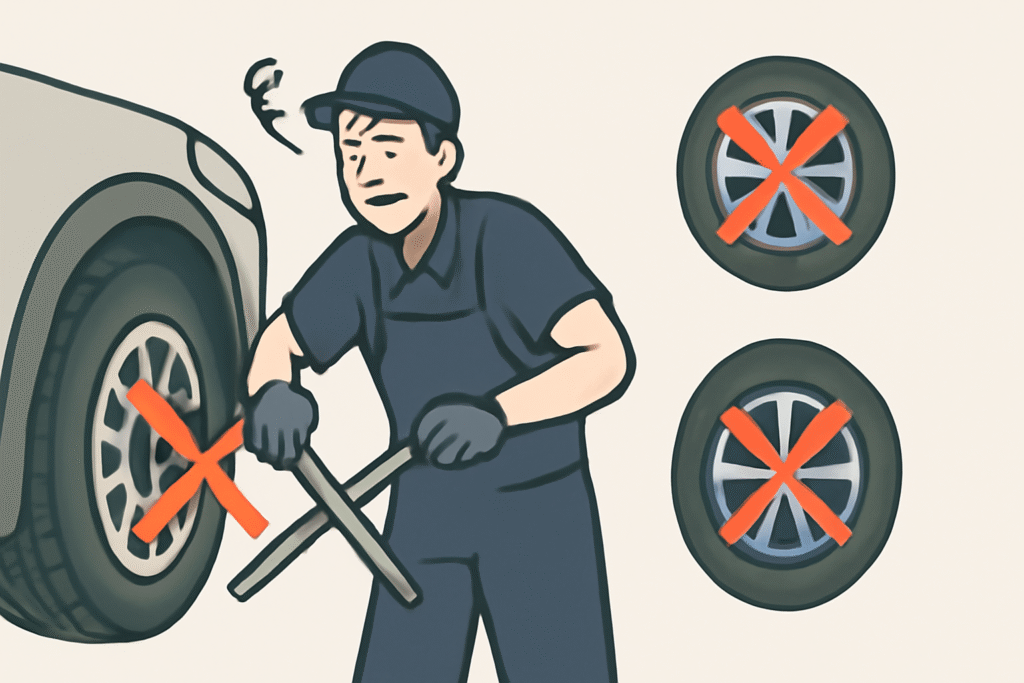
Tire Rotation and Alignment: What’s the Difference?
Tire rotation and alignment are both crucial for maintaining your vehicle’s performance and extending the life of your tires. But they serve very different purposes. Here’s what you need to know to understand both processes and why they matter.
What is Tire Rotation?
Tire rotation involves moving your tires from one position to another to ensure even wear. Over time, tires wear differently depending on their position on the vehicle (e.g., front tires often wear faster on front-wheel drive vehicles). Regular tire rotation helps distribute wear more evenly across all four tires, improving vehicle handling, fuel efficiency, and safety.
- When to Rotate Tires: Generally every 6,000 to 8,000 miles (or as recommended by your vehicle’s manufacturer).
- Main Benefit: Even tire wear and prolonged tire life.
What is Tire Alignment?
Tire alignment, on the other hand, refers to adjusting the angles of your tires to ensure they are perpendicular to the ground and parallel to each other. When your wheels are misaligned, your tires don’t meet the road at the correct angle, which can cause uneven wear, poor handling, and a decrease in fuel efficiency. Alignment also helps ensure that your car drives straight and doesn’t pull to one side.
- When to Align Tires: Usually every 1-2 years or if you notice uneven tire wear, pulling to one side, or if you’ve recently hit a curb or pothole.
- Main Benefit: Proper tire alignment enhances vehicle stability, handling, and tire life.
Key Differences Between Tire Rotation and Alignment
- Tire Rotation: A regular maintenance task that ensures all tires wear evenly by changing their positions on the vehicle.
- Tire Alignment: A technical adjustment of the wheel angles to prevent uneven wear and improve vehicle handling.
Why Both Are Important
While tire rotation helps ensure that your tires wear evenly, alignment ensures that the tires are properly aligned for optimal performance. Without a proper alignment, even the best tire rotation won’t prevent premature wear and poor vehicle handling. Think of tire rotation as keeping the tires balanced, while alignment ensures they’re positioned perfectly for the road.

Tire Wear and What It Tells You About Your Vehicle
Tire wear patterns can tell you a lot about the health of your vehicle and how it’s performing. By learning to identify these patterns, you can catch issues early, saving money on repairs and improving your safety. Here’s what you need to know about different types of tire wear and what they mean for your car.
1. Uneven Tread Wear
If your tire tread is worn unevenly—such as one side being more worn than the other—it could indicate a problem with your alignment or suspension.
- Causes:
- Misalignment: When your wheels aren’t aligned properly, it can cause uneven contact with the road, leading to one side of the tire wearing faster than the other.
- Suspension Issues: Worn-out suspension components can cause your tires to wear unevenly because they aren’t sitting at the proper angle on the road.
- What It Tells You: It’s time to get your vehicle aligned or check your suspension for damage. Ignoring this could lead to premature tire replacement and compromised handling.
2. Center Wear
If the tread in the center of the tire is more worn down than the edges, it’s a sign of over-inflation. This happens when the tire pressure is too high, causing the middle of the tire to make more contact with the road than the edges.
- Causes:
- Over-inflation: Driving with tires that are over-inflated reduces the contact patch and forces more pressure on the center of the tire.
- What It Tells You: Lower your tire pressure to the manufacturer’s recommended level. Proper tire pressure not only extends tire life but also improves fuel efficiency and safety.
3. Edge Wear
If the edges of your tires are worn more than the center, it’s likely due to under-inflation. This happens when your tire pressure is too low, causing more of the tire’s surface to make contact with the road’s edges.
- Causes:
- Under-inflation: Low tire pressure increases friction at the tire’s edges, causing faster wear and reducing the tire’s effectiveness.
- What It Tells You: Check your tire pressure regularly and inflate your tires to the recommended level to prevent uneven wear and maintain proper tire performance.
4. Cup-Shaped Wear
If you notice a bumpy or uneven wear pattern, especially on the inside of the tire, this could indicate a suspension problem or issues with balancing. It can feel like the vehicle is vibrating while driving.
- Causes:
- Worn-out shocks or struts: These components help keep your tires in constant contact with the road. When they’re worn, it can cause uneven tire wear.
- Poor balancing: Incorrectly balanced tires can lead to vibrations and uneven wear.
- What It Tells You: Have your suspension and wheel balancing checked by a professional to prevent further damage and improve ride quality.
5. Scalloping or Zig-Zag Wear
If your tires develop a zig-zag or scalloped pattern, it’s often a sign of improper wheel alignment, poor balancing, or issues with your vehicle’s suspension system.
- Causes:
- Improper alignment or balancing: If the tires are not properly aligned or balanced, they may wear in a way that creates a rough, uneven surface.
- What It Tells You: Get your wheels aligned and balanced to avoid more severe tire damage and improve the overall safety of your vehicle.
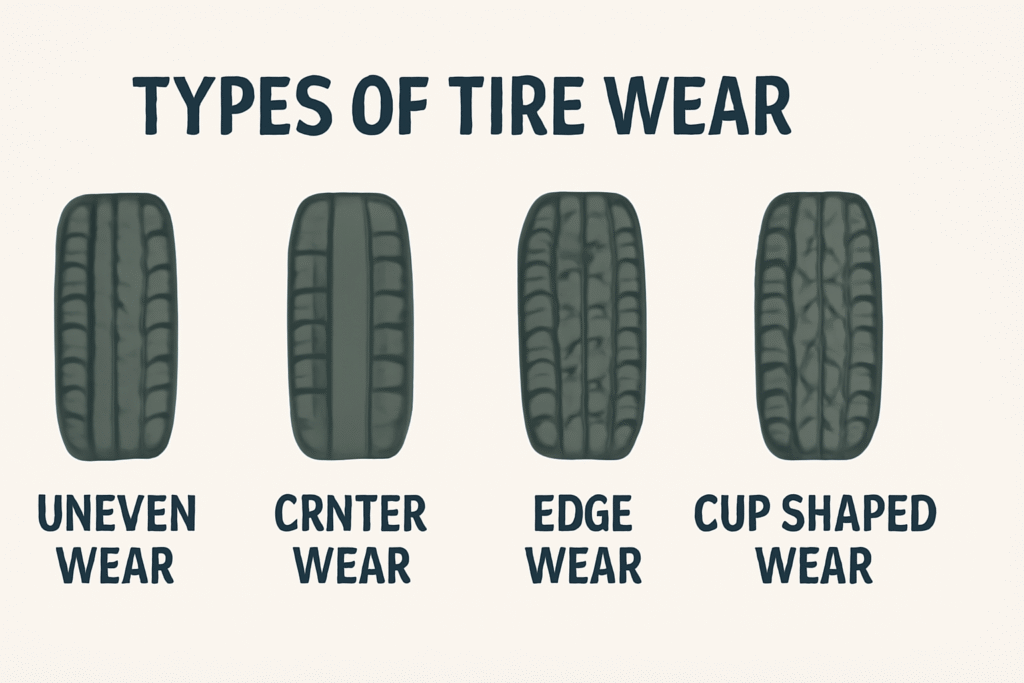
The Importance of Tire Rotation for a Smooth Ride
Tire rotation might seem like a small task, but its impact on your vehicle’s performance, safety, and cost-efficiency is huge. By regularly rotating your tires, you ensure even wear, extend their lifespan, and improve fuel efficiency—all while enhancing your vehicle’s handling and safety.
Remember, proper tire maintenance goes beyond just rotating them; keeping an eye on tire pressure, alignment, and overall condition will help you avoid costly repairs and keep your car running at its best. With simple steps and a little effort, you can protect your investment and enjoy a smoother, safer ride.
So, make tire rotation a regular part of your car care routine. Your tires, your vehicle, and your wallet will thank you in the long run!

Frequently Asked Questions (FAQ)
1. How often should I rotate my tires?
It’s recommended to rotate your tires every 6,000 to 8,000 miles, or as suggested in your vehicle’s owner manual. Regular rotation ensures even tire wear, prolonging tire life and improving vehicle performance. Some vehicles may require more frequent rotations depending on driving habits or tire type. 🛠️
2. Can I rotate my tires myself?
Yes, you can rotate your tires yourself if you have the right tools and a basic understanding of the process. You’ll need a car jack, lug wrench, and torque wrench. However, if you’re unsure, it’s always safe to have a professional do it. 🚗
3. What happens if I don’t rotate my tires?
If you skip tire rotations, your tires will wear unevenly, which can lead to poor handling, reduced safety, and a shorter tire lifespan. This can also affect your car’s fuel efficiency and may require premature tire replacement. 🔧
4. How do I know if my tires need to be rotated?
You should rotate your tires every 6,000 to 8,000 miles, but if you notice signs of uneven wear, such as the car pulling to one side or vibrations, it’s a sign your tires may need a rotation. Regular visual checks for uneven tread wear can also help. 👀
5. What is the best way to rotate tires?
The best way to rotate tires depends on your vehicle’s drivetrain:
- Front-Wheel Drive: Front tires go to the rear and swap sides.
- Rear-Wheel Drive: Same pattern as front-wheel drive.
- All-Wheel Drive: Use an X-pattern rotation (swap both front and rear tires, crossing sides). 🔄
6. Can tire rotation improve gas mileage?
Yes! By ensuring that all tires wear evenly, tire rotation can reduce rolling resistance, helping your car perform more efficiently and improve gas mileage. Keeping your tires properly maintained also enhances overall vehicle performance. ⛽
7. How tight should lug nuts be after rotating tires?
Lug nuts should be tightened to the vehicle manufacturer’s recommended torque specification. Use a torque wrench to ensure they are not too tight or too loose. Over-tightening or under-tightening can damage the tire or cause it to come loose while driving. ⚖️
8. Should I align my tires after rotating them?
While tire rotation ensures even wear, it doesn’t fix alignment issues. If you notice that your car pulls to one side or your tires show uneven wear, it’s a good idea to get your alignment checked. Proper alignment improves tire longevity and vehicle stability. 🛠️



















